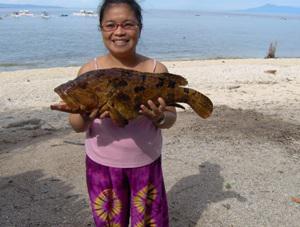Margarita N. Lavides
My main goal is to answer the question: how threatened are Philippine marine reef fish species due to fishing?

Photo taken while doing fieldwork in Balicasag island during an early morning fish catch monitoring at a landing site in Balicasag with me holding an Epinephelus grouper caught by a fisher by hook and line after close to three hours of fishing.
The Philippines which lies in the epicentre (Carpenter & Springer 2005) and in the world’s most threatened region of marine biodiversity (Roberts et al. 2002), is probably losing marine fish species, yet we know almost nothing about it. Philippine marine fisheries landings are declining (Alcala & Russ 2002; Barut et al. 2004) but the trajectories of vulnerable species are rarely understood. Even the recent history of exploitation is poorly studied in most areas, and the baselines from which current depletions have descended are uncertain, meaning the targets for recovery objectives, where these might be addressed in the future are uncertain. Each human generation varies in its perception of a fishery and the perceptions which are essential for management have scarcely been studied in this region with its fast-growing human population.
Degradation of 70% of the Philippine coral reefs, over fishing and human population growth (Barut 2004) led to an annual reef fish production of 350,000 tonnes declining to about 177,500 tonnes by1990s (Alcala & Russ 2002). This study will give substance to the abundance trends in different groups and species of Philippine marine fishes using the multiple data sources. Information collected from several generations of fishermen creates a series of historical windows into a fishery’s local ecology that can be used to identify long term processes in the fishery (Ames 2001). Compiling an historical database such as those from fish collection records and from people’s perceptions forms a timeline that allows those processes to be studied. These will provide valuable inputs to the development of conservation and management plans and policies in the marine conservation and fisheries sector of the country.
In particular, this project will provide inputs to setting conservation priorities for exploited species or it will provide inputs to fisheries management of particular fishing grounds of the Philippines, e.g. Leyte Gulf At the very least, the project will substantiate the abundance trends of at least 20 marine fish species included in the top 30 species of Philippine fisheries. Since the work will be done in collaboration with the national Bureau of Fisheries and Aquatic Resources (BFAR) through the National Fisheries Research and Development Institute (NFRDI), the Philippine National Museum and the Coastal Conservation and Education Foundation with whom letters of agreement have already been exchanged and face-to-face meetings in the scoping study done, the output of this project will be readily taken up by relevant end users.